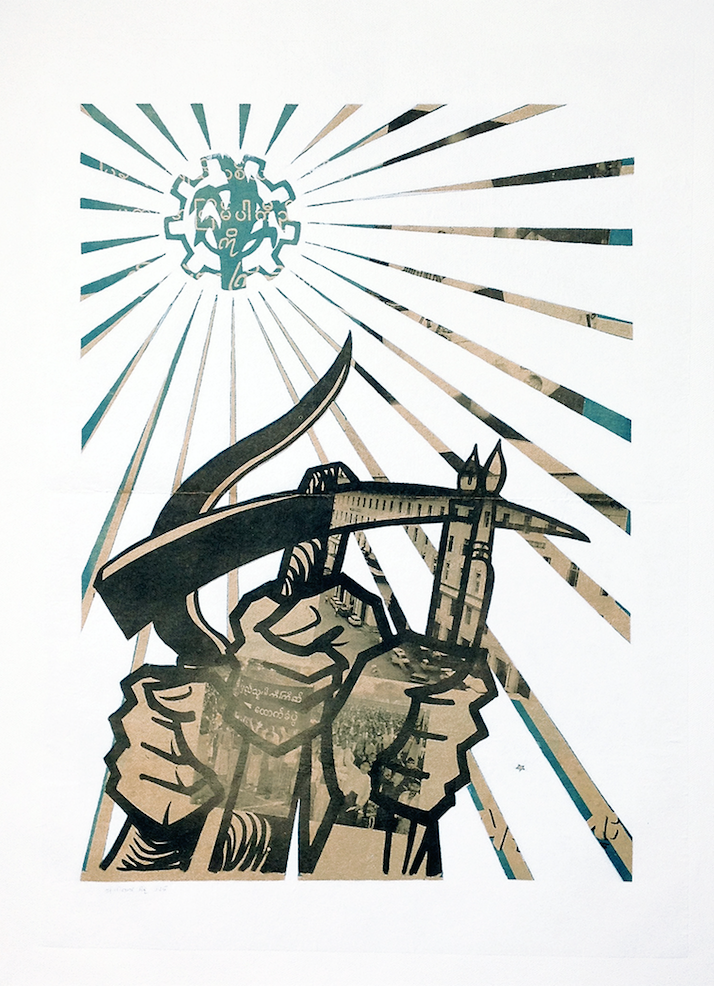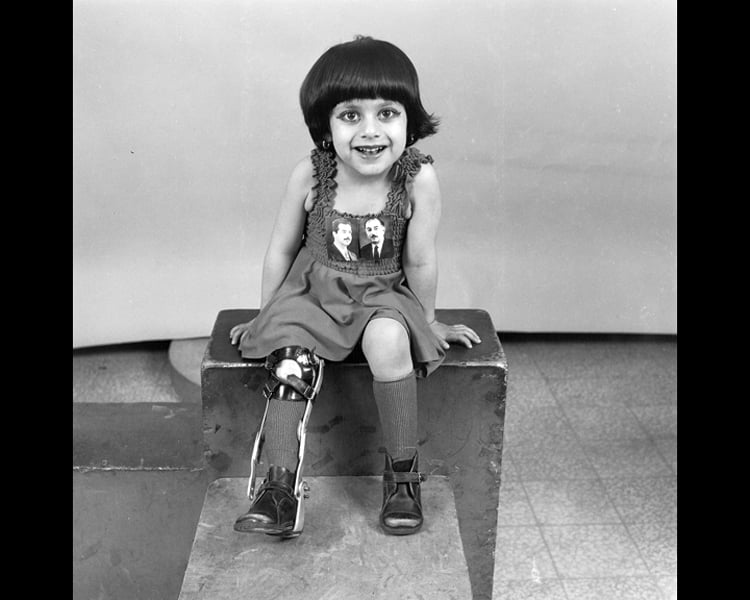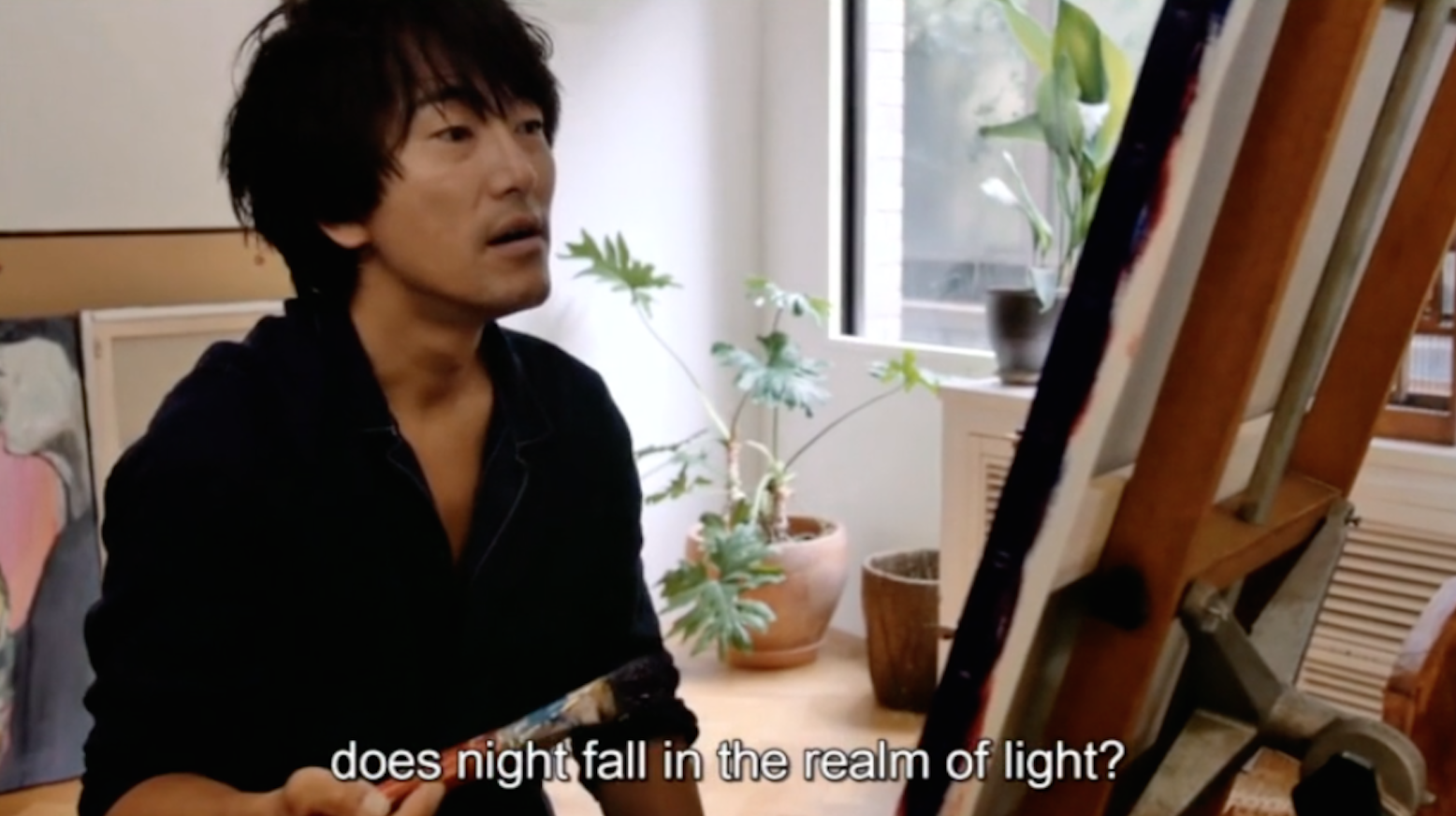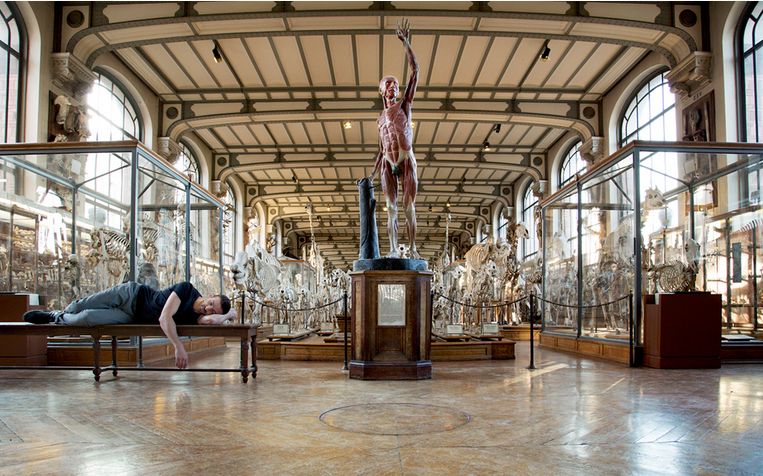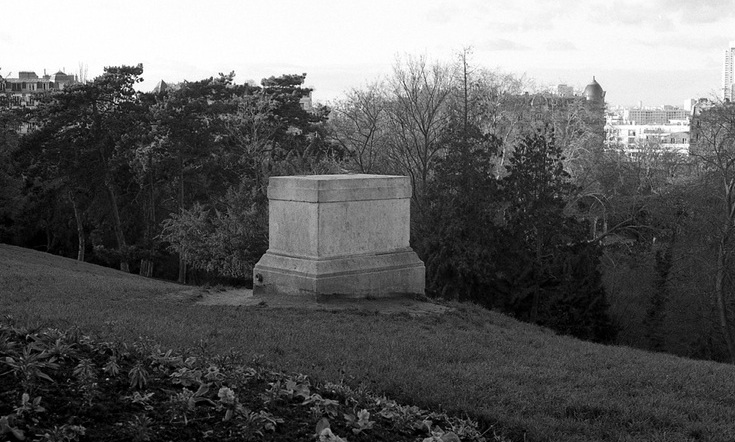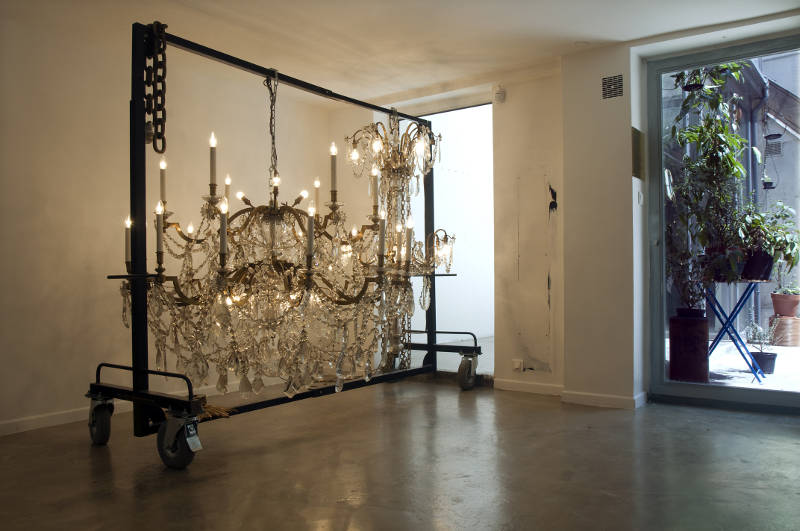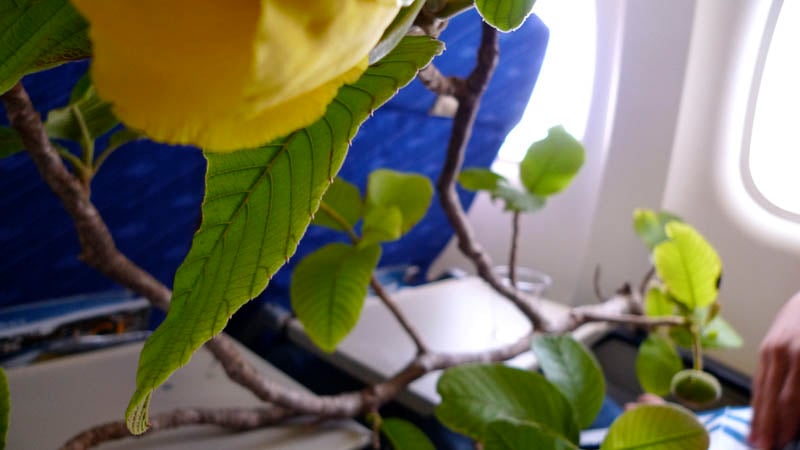
© » KADIST
Kelly Sinnapah Mary
Notebook 10 , l ‘enfance de sanbras (The Childhood of Sanbras) series by Kelly Sinnapah Mary is a sequel to an earlier series by the artist titled Cahier d’un non retour au pays natal (2015). This earlier work considers the process of reconstructing an identity of the Indian workers who arrived in the Caribbean during the post-slavery period. The work addresses the conditions of recruitment of these Indian workers, the strategies of the recruiters, how they lured them onto ships to bring them back to the plantations.

© » KADIST
Kelly Sinnapah Mary
Notebook 10 , l ‘enfance de sanbras (The Childhood of Sanbras) series by Kelly Sinnapah Mary is a sequel to an earlier series by the artist titled Cahier d’un non retour au pays natal (2015). This earlier work considers the process of reconstructing an identity of the Indian workers who arrived in the Caribbean during the post-slavery period. The work addresses the conditions of recruitment of these Indian workers, the strategies of the recruiters, how they lured them onto ships to bring them back to the plantations.

© » KADIST
Ali Yass
Drawing & Print (Drawing & Print)
Now; 1992 is Ali Yass’s attempt to remake his childhood drawings, which were lost after he was forced to leave Iraq following the 2003 US occupation. The drawings are chimeric compositions of animated limbs, animal, human, and machine, that seem to hurl in all directions and mediums, unified as colorful figurations posed against blank backgrounds, rendering the curious characters suspended in time. This suspension materializes the artist’s view on violence and temporality, on which he has claimed: “I will not talk about war because it is from the past.

© » KADIST
Kelly Sinnapah Mary
Notebook 10 , l ‘enfance de sanbras (The Childhood of Sanbras) series by Kelly Sinnapah Mary is a sequel to an earlier series by the artist titled Cahier d’un non retour au pays natal (2015). This earlier work considers the process of reconstructing an identity of the Indian workers who arrived in the Caribbean during the post-slavery period. The work addresses the conditions of recruitment of these Indian workers, the strategies of the recruiters, how they lured them onto ships to bring them back to the plantations.
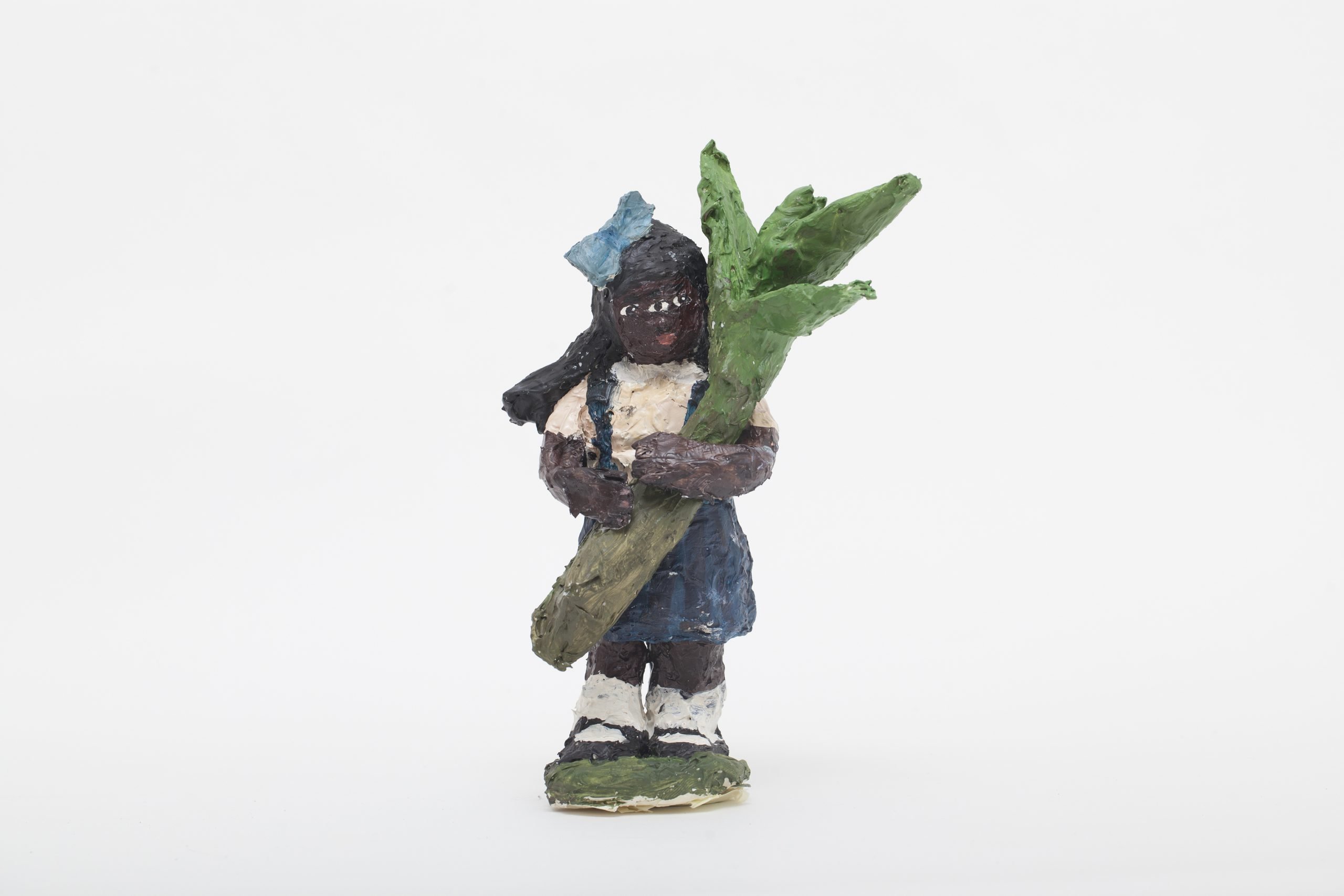
© » KADIST
Kelly Sinnapah Mary
Notebook 10 , l ‘enfance de sanbras (The Childhood of Sanbras) series by Kelly Sinnapah Mary is a sequel to an earlier series by the artist titled Cahier d’un non retour au pays natal (2015). This earlier work considers the process of reconstructing an identity of the Indian workers who arrived in the Caribbean during the post-slavery period. The work addresses the conditions of recruitment of these Indian workers, the strategies of the recruiters, how they lured them onto ships to bring them back to the plantations.

© » KADIST
Kelly Sinnapah Mary
Notebook 10 , l ‘enfance de sanbras (The Childhood of Sanbras) series by Kelly Sinnapah Mary is a sequel to an earlier series by the artist titled Cahier d’un non retour au pays natal (2015). This earlier work considers the process of reconstructing an identity of the Indian workers who arrived in the Caribbean during the post-slavery period. The work addresses the conditions of recruitment of these Indian workers, the strategies of the recruiters, how they lured them onto ships to bring them back to the plantations.

© » KADIST
Dana Kavelina
Letter to a Turtledove by Dana Kavelina is a short film based on a poem written by the artist. Delivered as a monologue and presented with subtitles, the poem encapsulates the traumas, grievances, horrors, dreams, and hallucinations that have descended upon Ukraine’s Donbass region since its invasion by Russia in 2014. Appropriating amateur footage shot during the war in the Donbass region, Kavelina’s film weaves sound and image into a poignant tapestry that considers the absurdity of war.

© » KADIST
Kelly Sinnapah Mary
Notebook 10 , l ‘enfance de sanbras (The Childhood of Sanbras) series by Kelly Sinnapah Mary is a sequel to an earlier series by the artist titled Cahier d’un non retour au pays natal (2015). This earlier work considers the process of reconstructing an identity of the Indian workers who arrived in the Caribbean during the post-slavery period. The work addresses the conditions of recruitment of these Indian workers, the strategies of the recruiters, how they lured them onto ships to bring them back to the plantations.

© » KADIST
Native Art Department International
The neon sign Walk the Walk (Sam Durant) overlays a Walk/Don’t Walk Sign crosswalk sign onto the text “You Are On Indian Land Show Some Respect.” The sign asks viewers to not walk on Indigenous lands without respecting it, and, switching between a walking person icon in white and a raised hand icon in red, redirects their actions. This work by Native Art Department International signals a reminder that we–the audience and institution–are located on and occupy traditional territories. The work appropriates and twists white artist Sam Durant’s You Are On Indian Land Show Some Respect (2008) in response to his work Scaffold (2012) installed in 2016-7 at the Walker Art Center in Minneapolis.

© » KADIST
Kelly Sinnapah Mary
Notebook 10 , l ‘enfance de sanbras (The Childhood of Sanbras) series by Kelly Sinnapah Mary is a sequel to an earlier series by the artist titled Cahier d’un non retour au pays natal (2015). This earlier work considers the process of reconstructing an identity of the Indian workers who arrived in the Caribbean during the post-slavery period. The work addresses the conditions of recruitment of these Indian workers, the strategies of the recruiters, how they lured them onto ships to bring them back to the plantations.

© » KADIST
Michael Armitage
In “And so it is” shows the image of a faceless man before a microphone, ready to deliver an important message. The viewer is faced with the familiar image of political power seen in our homes on the television, yet this time located in a whimsical abstract landscape. The speaker appears as a shadow in front of a crowd that is responding to him by holding bubbles containing images of animals and plants.

© » KADIST
Kelly Sinnapah Mary
Notebook 10 , l ‘enfance de sanbras (The Childhood of Sanbras) series by Kelly Sinnapah Mary is a sequel to an earlier series by the artist titled Cahier d’un non retour au pays natal (2015). This earlier work considers the process of reconstructing an identity of the Indian workers who arrived in the Caribbean during the post-slavery period. The work addresses the conditions of recruitment of these Indian workers, the strategies of the recruiters, how they lured them onto ships to bring them back to the plantations.

© » KADIST
Mounira Al Solh
In 2011, Mounira Al Solh began a series of drawings that documented her meetings and conversations with displaced Syrian refugees in Lebanon and various European countries. The oral histories she collected are very different from those told in administrative interviews or police interviews. My specialty was to make a peasants’ haircut, but they obliged me work till midnight often (2017) is part of a series of embroideries that speaks to how personal stories in this political context create collective history.

© » KADIST
Kiluanji Kia Henda
Redefining The Power (with Didi Fernandes) is a metaphor of how reflections on history and society during the Angolan Civil War (1975-2002) are largely ignored within the canon of history. Resulting from Kia Henda’s research on the Fortaleza de São Miguel built by the Portuguese in the 15th century in Luanda, Angola, the Redefining The Power series was created 10 years after the Angolan Civil War as a reflection on the reactivation of memory surrounding historical monuments. Through this work, the artist aims to replace the memorialized colonial heroes and war symbols through re-appropriation, determining traumatized lands as forms of resistance and pride.

© » KADIST
Gisela McDaniel
Got Your Back by Gisela McDaniel depicts two women of color from different ethnic backgrounds who share similar violent experiences. However, the sitters never met and were depicted separately by artist Gisela McDaniel. The painting is thus an artificial construct, whose warm, gentle and seemingly benign look Is undermined by the accompanying soundtrack detailing their horrific experiences.

© » KADIST
Shooshie Sulaiman
Drawing & Print (Drawing & Print)
Shooshie Sulaiman’s pictures of unidentified figures initially appear alien and even monstrous: rendered hairless in unusual and even sickly colors, they stand in stark contrast to the aesthetic ideals of conventional portraiture. The subject in Dulu atas pedestal, sekarang dalampedestal / Before on pedestal, now inside (2005), a ball point pen and charcoal rendering of a bald figure with a wide-eyed stare, appears caught in a distressingly static state, at once both uncomfortable and yet incapable of ameliorating his condition. Sulaiman’s subject here becomes an almost frightening sight, the emotive brush strokes replaced by the ball point pen’s erratic black lines, the eyes and mouth scribbled over in a deliberately defacing gesture.
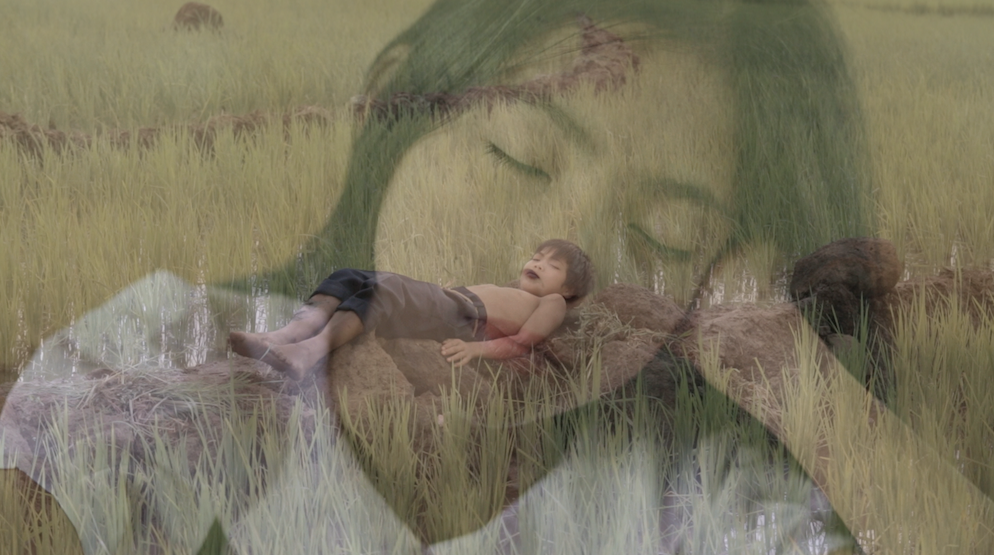
© » KADIST
Phan Thao Nguyên
Tropical Siesta begins in a rural landscape of Vietnam. Very quickly, painted images of students sleeping on their school benches appear. A text speaking of how the communist regime has placed agriculture at the center of its economy reads alongside the images.

© » KADIST
Jane Jin Kaisen and Guston Sondin-Kung
The Woman, The Orphan, and The Tiger begins with the sound of women’s voices describing histories of violence, of things repressed and silenced. Gradually, their voices accumulate into a cacophony of pure sonic intensity against an extreme slow-motioned image of a woman survivor of Japan’s military sexual slavery who, in the absence of words to accurately account for her suffering, gets up and walks into the center of a war crimes tribunal court room and gestures wildly before she faints. This work by Jane Jin Kasen and Guston Sondin-Kung explores ways in which trauma is passed on from previous generations to the present through a sense of being haunted.

© » KADIST
Kiri Dalena
Gikan Sa Ngitngit Nga Kinailadman (From The Dark Depths) by Kiri Dalena is a stylistically collaged film inspired by the true story of a young activist’s drowning. Moving between reality and fantasy, it depicts the story of a dead communist who sinks to the bottom of the ocean into a dreamlike subaquatic utopia. In the film a young woman mourns the death of an activist that took place years ago.

© » KADIST
Nguyen Thai Tuan
In the “Black Paintings” series, although the human body is only suggested, it plays an important role. Some body parts are absent, mostly the faces which are usually an affirmation of the individual. The characters recall ghosts testifying as to the traumas of war.

© » KADIST
Arin Rungjang
246247596248914102516… And then there were none narrates a semi fictional account centered around the ambiguous history of the Democracy Monument in Bangkok, and on the aftermath of the 1973 demonstration of 400,000 people who marched against the military junta from Thammasat University to the monument. Built on archival and oral history, the story interweaves the personal with grand historical narratives to consider the complicated history behind the monument – symbolic of the unrest and violence that led to the Thammasat University massacre on October 6, 1976.

© » KADIST
Vandy Rattana
Vandy Rattana’s Bomb Ponds series was made following a transformative encounter with the craters left over from 2,756,941 tons of bombs dropped by U. S. forces during the Vietnam War between 1964 and 1973. Dissatisfied with the level of documentation on the bombing and its repercussions, the artist began to study the historiography of his country. He travelled to the ten most severely bombed provinces, engaging villagers in locating and testifying to the existence of the craters, and how they are lived with today.

© » KADIST
Eamon Ore-Giron
Eamon Ore-Giron’s new commissioned video project Bite Work, is an experimental genre breaking video that is part-performance, part-conceptual and part-comical addressing issues of mediation, surveillance and trust. The main characters in the video wear traditional dance masks of “La Chonguinada” rituals from Peru and attempt to dance while being bitten by trained attacked dogs. Through this act, the dogs simultaneously become sculptural obstacles and dancers.

© » KADIST
Didem Pekün
The black-and-white projection, Araf by Didem Pekün, begins, as a lithe man stands high up in the middle of the grand, rebuilt 16th-century Ottoman bridge in Mostar, in Bosnia and Herzegovina. In very slow motion, he soars through the air like a bird in a graceful dive. We never see him land.
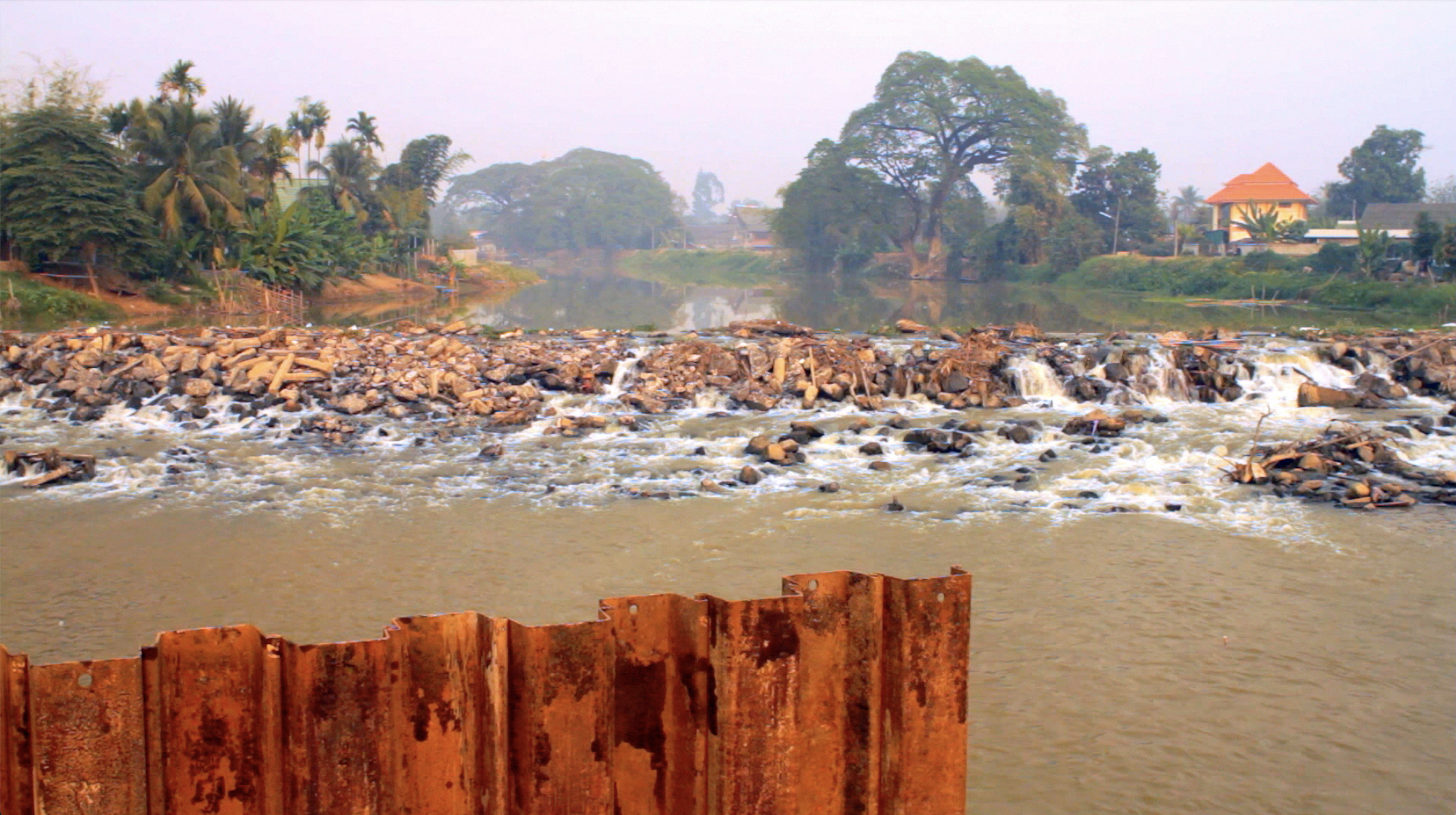
© » KADIST
Som Supaparinya
The flat, wide river holds on its surface a tour-boat of memories, as Som Supaparinya documents her Grandfather’s return via cruise to familiar territories in rural Thailand that were submerged after the Thai government installed a series of dams. An unsettling sense of trauma emerges from the absence of what is being described in My Grandpa’s Route has been Forever Blocked . Supaparinya’s juxtaposition of unceasing waterways and cruise life with a series of dams, obstinately responsible for these conditions.

© » KADIST
Titus Kaphar
Although the objects depicted in Titus Kaphar’s diptych 2016/1963 might not be immediately recognizable, the work’s title and the inscriptions ‘Alabama 1963’ and ‘North Dakota 2016’ reveal their use as tools of brutal force. The work with the inscription ‘Alabama 1963’ is a painting of the nozzle of a high-pressure water jet that the Birmingham Police used against black protesters, including children, during a non-violent campaign against racial segregation led by Martin Luther King JR. during the civil rights movement. The second painting depicts the nozzles used against protestors that in 2016 opposed the plans to build the Dakota Access pipeline near the Standing Rock Indian Reservation, many of whom were seriously hurt and left soaking wet during freezing temperatures.

© » KADIST
Mike Cloud
In his series Hanging and Beheading Paintings Mike Cloud speaks to the suffering of a series of named (and occasionally unnamed) individuals, addressing their trauma within the language of abstraction. They offer the viewer an aesthetic account of individuality, death, and the empathic space of communion in absence via avant-garde portraiture, unbound by the rules of anatomy or even representation, but instead by purely expressive compositional and aesthetic goals. Untitled (Beheading) embraces the individual subjectivities of notable and mundane contemporaries — from pop stars to serial killers — in cryptic ways, connected only by the physical circumstances of their deaths.

© » KADIST
Aubrey Williams
Carib Carnival illustrates Aubrey Willams’s unique artistic language, combining Pre-Columbian iconography with abstraction. A series of abstracted shapes that resemble bones, masks and serpent-like images surrounded by fiery vapors and gases, illustrate the destruction of culture as one of the predominant themes of Williams’s work. He considered the Mayan and Aztec cultures to exemplify a number of present-day faults; according to Williams they developed technologies that would eventually lead to their own destruction.
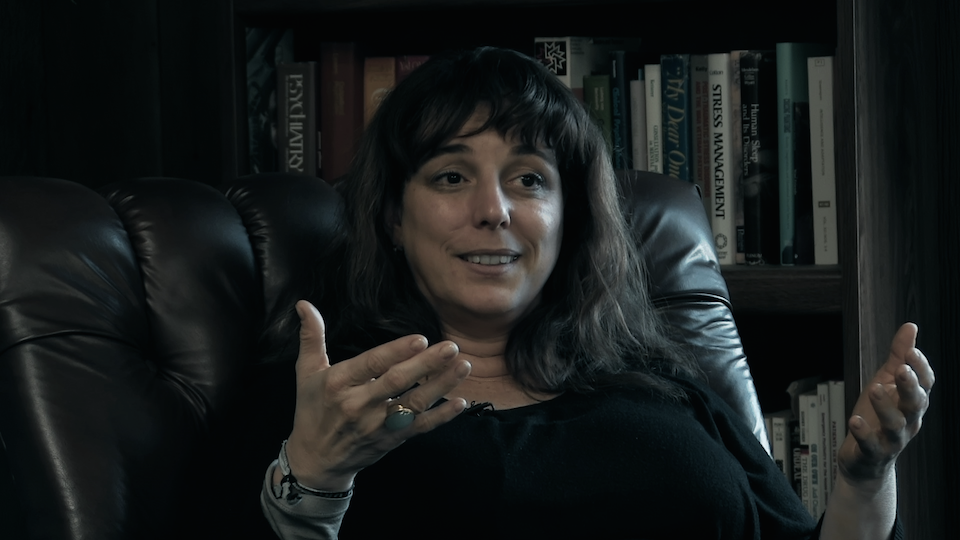
© » KADIST
Lynn Hershman Leeson
Tania Libre is a film by Lynn Hershman Leeson centered around renowned artist Tania Bruguera and her experience as a political artist and activist under the repressive government of her native Cuba. The film begins with the voice of Tilda Swinton narrating a manifesto of artists’ rights written by Bruguera in which she expresses her views on art, our universal right to both enjoy and create art, and the duty that artists have to dissent. The film then captures a series of therapy sessions between Bruguera and Dr. Frank M. Ochberg—the founding father of trauma therapy, particularly PTSD and Stockholm Syndrome—where Bruguera describes with great candor and earnestness several traumatic experiences such as the betrayal by her father who handed her to Cuban secret service, and her imprisonment in Havana years later after advocating for freedom of expression.

© » KADIST
Enrique Ramirez
Enrique Ramirez’s La Memoria Verde is a work of poetry, politics, and memory created in response to the curatorial statement for the 13th Havana Biennial in 2019, The Construction of the Possible . Other well known works by Ramirez feature the movement and endless symbolism of the sea—like the simultaneous engagement and retreat of the tide—but La Memoria Verde takes the land, plant life, and its human inhabitants as its subject. The film begins with a soft, green, algae-like image that waxes and wanes in focus, then gives way to swaying treetops blowing in a soft wind.
Kelly Sinnapah Mary
Kelly Sinnapah Mary is a multidisciplinary artist who’s work is informed by the diasporic journey of her ancestors...
Shooshie Sulaiman
Shooshie Sulaiman is one of the leading creative practitioners in Southeast Asia...
Sancintya Mohini Simpson
Sancintya Mohini Simpson is an artist, writer, and researcher whose work addresses the impact of colonization on the historical and lived experiences of her family and broader diasporic communities...
Elham Rokni
Born just after the Islamic Revolution, Elham Rokni (b...
Gisela McDaniel
Chamorro artist Gisela McDaniel depicts Native American and mixed-race women from the USA’s former, as well as current, Pacific territories...
Vandy Rattana
A self-taught photographer, Vandy Rattana has focused on challenging conditions in Cambodia, his home country, by documenting natural and manmade disasters...
Tun Win Aung and Wah Nu
Wah Nu and Tun Win Aung, respectively born in 1977 and 1975, Yangon, Myanmar...
Titus Kaphar
Titus Kaphar’s work is often discussed as socially and politically oriented, however, the artist describes it as a series of deeply personal responses to situations, narratives or histories...
Arin Rungjang
Arin Rungjang’s practice is known to revisit historical and political narratives, both major and minor, as a means to consider the past, present and future...
Kiri Dalena
Kiri Dalena is an acclaimed visual artist, filmmaker, and activist...
Uriel Orlow
In his research-based and process-oriented practice Uriel Orlow’s work is concerned with “spatial manifestations of memory, blind spots of representation and forms of haunting”...
Aubrey Williams
Aubrey Williams was one of the founding members of the Caribbean Artists Movement, formed in the 1960s in the United Kingdom, after settling there in the early 1950s...
Lynn Hershman Leeson
- location: San Francisco, California
- year born: 1941
- gender: female
- nationality: American
- home town: Cleveland, Ohio
Kudzanai-Violet Hwami
UK-based artist, Kudzanai-Violet Hwami was born in Gutu, Zimbabwe in 1993 and lived in South Africa from the ages of 9 to 17...
Som Supaparinya
Humanity is not ontologically transcendent, artist Som Supaparinya’s work makes adamantly clear: actions energetically create impacts, experience dictated not only by our perceptions but equally the world that surrounds us, tethered inextricably...
Clemens von Wedemeyer
- location: Göttingen, Deutschland
- year born: 1974
- gender: male
- nationality: German
Eamon Ore-Giron
Eamon Ore-Giron’s paintings, works on paper and installations blend contemporary graphic design, folk and tourist art, and surrealism in a hybridity of Mexican, South American, Native-American, and other American cultures...
Virlani Hallberg
Virlani Hallberg is a video and photographic artist living and working in Berlin...
Jane Jin Kaisen and Guston Sondin-Kung
Working with narrative experimental film, multi-channel video installation, performative video art, photography, and text, Jane Jin Kaisen engages themes of memory, trauma, migration and translation at the intersection of personal and collective histories...
Mike Cloud
Artist Mike Cloud builds irregularly shaped canvases and frames into unique sculptural objects...
Enrique Ramirez
- year born: 1979
- gender: male
- nationality: Chilean
- home town: Santiago, Chile
Native Art Department International
Native Art Department International is a collaborative project created in 2016 and administered by Maria Hupfield and Jason Lujan...
Moshekwa Langa
The oeuvre of Moshekwa Langa (b...
Dana Kavelina
Dana Kavelina is an artist and activist who works with video, animation, painting, illustration, and text...
Mounira Al Solh
Mounira Al Solh’s art practice embraces inter alia drawing, painting, embroidery, performative gestures, video and video installations...
Michael Armitage
Michael Armitage (b...
Akram Zaatari
- location: Sayda, Al-Lubnan
- year born: 1966
- gender: male
- nationality: Lebanese
Kiluanji Kia Henda
A self-taught artist, Kiluanji Kia Henda employs a strong sense of humour in his work, which often hones in on themes of identity, politics, and perceptions of post-colonialism and modernism in Africa...
Aki Kondo
Aki Kondo utilizes animation, video, and mixed media to explore such varied topics as intimacy, loss, and the human body...
Ali Yass
Ali Yass is a painter and filmmaker whose work entangles personal and collective memory in its psycho-affective interrogation of power...
-
1950-1959
Akram Zaatari
1957“These are negatives that were scratched because of a jealous husband from the Baqari family, who never let his wife out by herself...
-
1970-1979
Aubrey Williams
1972Carib Carnival illustrates Aubrey Willams’s unique artistic language, combining Pre-Columbian iconography with abstraction...
-
2000-2009
Moshekwa Langa
2004Hybridized drawing is a continued exploration in Moshekwa’s practice, integrating elements of graffiti, thread and yarn to enrich his abstract drawings of maps and space...
Shooshie Sulaiman
Drawing & Print
2005(Drawing & Print) Shooshie Sulaiman’s pictures of unidentified figures initially appear alien and even monstrous: rendered hairless in unusual and even sickly colors, they stand in stark contrast to the aesthetic ideals of conventional portraiture...
Shooshie Sulaiman
2005Shooshie Sulaiman’s pictures of unidentified figures initially appear alien and even monstrous: rendered hairless in unusual and even sickly colors, they stand in stark contrast to the aesthetic ideals of conventional portraiture...
Nguyen Thai Tuan
2008In the “Black Paintings” series, although the human body is only suggested, it plays an important role...
Dinh Q. Lê
2008Hill of Poisonous Trees (three men) (2008) exemplifies the artist’s signature photo-weaving technique, in which he collects diverse found photographs—portraits of anonymous people, stills from blockbuster films, or journalistic images—cuts them into strips, and weaves them into new composition...
Vandy Rattana
2009Vandy Rattana’s Bomb Ponds series was made following a transformative encounter with the craters left over from 2,756,941 tons of bombs dropped by U...
-
2010-2019
Jane Jin Kaisen and Guston Sondin-Kung
2010The Woman, The Orphan, and The Tiger begins with the sound of women’s voices describing histories of violence, of things repressed and silenced...
Eamon Ore-Giron
2011Eamon Ore-Giron’s new commissioned video project Bite Work, is an experimental genre breaking video that is part-performance, part-conceptual and part-comical addressing issues of mediation, surveillance and trust...
Kiluanji Kia Henda
2011Redefining The Power (with Didi Fernandes) is a metaphor of how reflections on history and society during the Angolan Civil War (1975-2002) are largely ignored within the canon of history...
Tun Win Aung and Wah Nu
2011Tun Win Aung and Wah Nu initiated the series 1000 Pieces (of White) in 2009, as a way to produce objects and images as a portrait of their shared life as partners and collaborators...
Som Supaparinya
2012The flat, wide river holds on its surface a tour-boat of memories, as Som Supaparinya documents her Grandfather’s return via cruise to familiar territories in rural Thailand that were submerged after the Thai government installed a series of dams...
Virlani Hallberg
2012In collaboration with psychoanalyst and cultural theorist Leon Tan, Receding Triangular Square explores traditional Chinese and Taiwanese modalities of psychological healing as alternatives to dominant Western psychiatric and therapeutic practices...
Emilija Škarnulyte
2013In the video, the artist follows her grandmother, Aldona, during her daily walk through the Grutas Park in Lithuania...
Michael Armitage
2015In “And so it is” shows the image of a faceless man before a microphone, ready to deliver an important message...
Elham Rokni
2015“The Wedding” is the centerpiece of a series of works centered on a film of the artist’s parents’ wedding in 1978, the year before the Iranian revolution that gave power to a religious fundamentalist regime...
Titus Kaphar
2016Although the objects depicted in Titus Kaphar’s diptych 2016/1963 might not be immediately recognizable, the work’s title and the inscriptions ‘Alabama 1963’ and ‘North Dakota 2016’ reveal their use as tools of brutal force...
Lynn Hershman Leeson
2016Tania Libre is a film by Lynn Hershman Leeson centered around renowned artist Tania Bruguera and her experience as a political artist and activist under the repressive government of her native Cuba...
Uriel Orlow
2016The series The Memory of Trees is specifically about trees, and what trees have witnessed in South Africa: for example, trees that were used as locations for slave trading, or trees that was during the anti-Apartheid struggle as a kind of identifier for a safe house for activists who were fleeing from security forces...
Mounira Al Solh
2017In 2011, Mounira Al Solh began a series of drawings that documented her meetings and conversations with displaced Syrian refugees in Lebanon and various European countries...
Kiri Dalena
2017Gikan Sa Ngitngit Nga Kinailadman (From The Dark Depths) by Kiri Dalena is a stylistically collaged film inspired by the true story of a young activist’s drowning...
Arin Rungjang
2017246247596248914102516… And then there were none narrates a semi fictional account centered around the ambiguous history of the Democracy Monument in Bangkok, and on the aftermath of the 1973 demonstration of 400,000 people who marched against the military junta from Thammasat University to the monument...
Didem Pekün
2018The black-and-white projection, Araf by Didem Pekün, begins, as a lithe man stands high up in the middle of the grand, rebuilt 16th-century Ottoman bridge in Mostar, in Bosnia and Herzegovina...
Native Art Department International
2018The neon sign Walk the Walk (Sam Durant) overlays a Walk/Don’t Walk Sign crosswalk sign onto the text “You Are On Indian Land Show Some Respect.” The sign asks viewers to not walk on Indigenous lands without respecting it, and, switching between a walking person icon in white and a raised hand icon in red, redirects their actions...
Enrique Ramirez
2019Enrique Ramirez’s La Memoria Verde is a work of poetry, politics, and memory created in response to the curatorial statement for the 13th Havana Biennial in 2019, The Construction of the Possible ...
Ali Yass
Drawing & Print
2019(Drawing & Print) Now; 1992 is Ali Yass’s attempt to remake his childhood drawings, which were lost after he was forced to leave Iraq following the 2003 US occupation...
Sancintya Mohini Simpson
Drawing & Print
2019(Drawing & Print) And words were whispered by Sancintya Mohini Simpson is a series of ten works on paper based on the lived experiences of Indian women taken to the Natal region of South Africa from the 1860s to the early 1900s to work in tea and sugarcane plantations during apartheid, which included servitude in its broadest and most sinister definition...
Kudzanai-Violet Hwami
2019This painting is the direct result of the artist’s research into her roots...
-
2020-2029
Dana Kavelina
2020Letter to a Turtledove by Dana Kavelina is a short film based on a poem written by the artist...
Gisela McDaniel
2020Got Your Back by Gisela McDaniel depicts two women of color from different ethnic backgrounds who share similar violent experiences...
Mike Cloud
2020In his series Hanging and Beheading Paintings Mike Cloud speaks to the suffering of a series of named (and occasionally unnamed) individuals, addressing their trauma within the language of abstraction...
Kelly Sinnapah Mary
2021Notebook 10 , l ‘enfance de sanbras (The Childhood of Sanbras) series by Kelly Sinnapah Mary is a sequel to an earlier series by the artist titled Cahier d’un non retour au pays natal (2015)...
Kelly Sinnapah Mary
2021Notebook 10 , l ‘enfance de sanbras (The Childhood of Sanbras) series by Kelly Sinnapah Mary is a sequel to an earlier series by the artist titled Cahier d’un non retour au pays natal (2015)...
Kelly Sinnapah Mary
2021Notebook 10 , l ‘enfance de sanbras (The Childhood of Sanbras) series by Kelly Sinnapah Mary is a sequel to an earlier series by the artist titled Cahier d’un non retour au pays natal (2015)...
Kelly Sinnapah Mary
2021Notebook 10 , l ‘enfance de sanbras (The Childhood of Sanbras) series by Kelly Sinnapah Mary is a sequel to an earlier series by the artist titled Cahier d’un non retour au pays natal (2015)...
Kelly Sinnapah Mary
2021Notebook 10 , l ‘enfance de sanbras (The Childhood of Sanbras) series by Kelly Sinnapah Mary is a sequel to an earlier series by the artist titled Cahier d’un non retour au pays natal (2015)...
Kelly Sinnapah Mary
2021Notebook 10 , l ‘enfance de sanbras (The Childhood of Sanbras) series by Kelly Sinnapah Mary is a sequel to an earlier series by the artist titled Cahier d’un non retour au pays natal (2015)...
Kelly Sinnapah Mary
2021Notebook 10 , l ‘enfance de sanbras (The Childhood of Sanbras) series by Kelly Sinnapah Mary is a sequel to an earlier series by the artist titled Cahier d’un non retour au pays natal (2015)...
Kelly Sinnapah Mary
2021Notebook 10 , l ‘enfance de sanbras (The Childhood of Sanbras) series by Kelly Sinnapah Mary is a sequel to an earlier series by the artist titled Cahier d’un non retour au pays natal (2015)...
Kelly Sinnapah Mary
2021Notebook 10 , l ‘enfance de sanbras (The Childhood of Sanbras) series by Kelly Sinnapah Mary is a sequel to an earlier series by the artist titled Cahier d’un non retour au pays natal (2015)...
Sancintya Mohini Simpson
2021Dhuwã (term used by indentured people of Natal for ‘smoke’), is a single-channel film by Sancintya Mohini Simpson that traces back to the lived experiences of indentured labourers taken from India to Natal (now KwaZulu-Natal, South Africa) to work on sugar plantations during the late 1800s and early 1900s...
Kelly Sinnapah Mary
2021Notebook 10 , l ‘enfance de sanbras (The Childhood of Sanbras) series by Kelly Sinnapah Mary is a sequel to an earlier series by the artist titled Cahier d’un non retour au pays natal (2015)...



